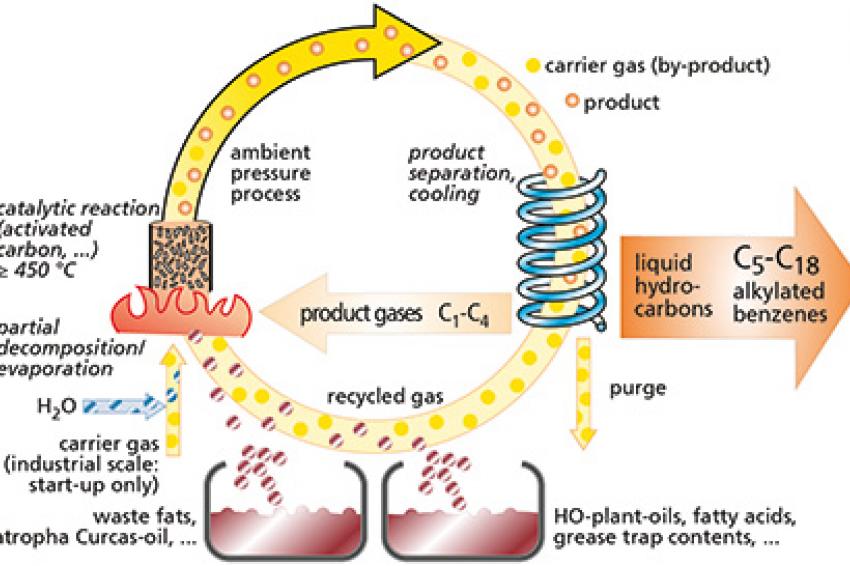Bio Jet Fuel
Alternative Bio-Based Fuel from Non-Food Resources and Residues Meets Kerosene Standards
Green Air Travel - Continuous growth of air traffic and its corresponding increase in CO2 emissions can be offset by high-quality bio jet fuels that meet all kerosene-related parameters. Some technologies are already certified and on the market. An innovative new technology uses bio-based nonfood resources and residues and, therefore, broadens the raw material basis for bio jet fuels and has the potential to supplement existing technologies.
Aviation Industry Growth and Related CO2 footprint
Aviation is, among all transport sectors, growing strongly: Annual growth rates are projected at approximately 4.5% per year throughout the next decades. The majority of this growth is expected to be linked to Southeast Asia. Technological progress in the aviation industry - mainly more energy-efficient planes - might reduce the fuel consumption a bit. Yet without further changes in the fuel sector, aviation-related CO2 emissions would increase by 3% per year.
The aviation industry expects to be reliant on liquid fuels for the next 30 to 50 years, since no alternatives for biofuels - like batteries for cars - exist for airplanes.
This would put even more pressure on the CO2 footprint of aviation: Already today, 12% of transport CO2 emissions and 3% of all synthetic CO2 emissions are due to aviation. European airlines consumed 53 million tons of kerosene in 2010; the whole world used 200 million tons.
Challenges For Aviation Companies
Governmental bodies are discussing joint targets and implementing several regulative actions in this context. The European Union decided in its Renewables Energy Directive (RED) to use 10% renewable energy in the transport sector by 2020 and is shooting for 2 million tons of "sustainable" kerosene by 2020. Details can be found in the technical paper "A Performing Biofuels Supply Chain for EU Aviation" of DG ENER 2011.
Aviation companies agreed on a voluntary commitment to grow only in a climate-neutral way from 2020 onward. They are, however, confronted by several challenges. Their cost pressure is tremendous, and fuel costs are continuously increasing: More than 30% of operating costs in aviation are due to fuel. Established biofuels for land transport like bioethanol and biodiesel cannot be used in airplanes because of their fuel properties - air transport requires biofuels that are chemically identical to fossil kerosene.
State-of-the-Art Processes for Bio Jet Fuel
State-of-the-art for producing alternative fuels not based on fossil oils is summarized in an International Air Transport Association (IATA) report. Basically, ASTM accepts two routes:
First, there is the so-called Fischer-Tropsch (FT) process. In particular CTL, GTL and BTL (coal-, gas- and biomass-to-liquid) products are addressed. It implies gasification of feedstock to syngas with ash as a byproduct. Syngas is converted further to a mixture of fuels containing naphtha, olefins, kerosene, diesel and waxes, which are treated in several steps by so-called hydroprocessing and isomerization to yield fuels including jet fuel. Since those processing steps require very large units, typically more than 50% of fuel costs are due to investment costs.
Second, there are so-called hydrogenated vegetable oils, sometimes also called hydroprocessed renewable jet (HRJ). Processing steps comprise, besides distillation, the steps hydrotreating, hydrocracking and isomerization. Raw materials include nonfood and recycled fats and oils. Here, more than 50% of fuel costs are due to raw materials. The hydrotreating step requires much hydrogen, which currently can be obtained only from fossil sources. The technology is much more developed than the FT technology for renewable raw materials. To preserve the activity of the hydrotreating catalyst, only feedstock displaying food-quality parameters can be used. Palm oil and tallow fat are the preferred raw materials because of their high degree of saturation requiring the lowest amount of hydrogen.
Technologies Not Yet Considered by ASTM but Lining up for Testing:
- Hydroprocessed synthetic paraffinic kerosene (SPK) derived from fermented alcohols. Initially focused on iso-butanol, but other variations will be considered, too (alcohol-to-jet, e.g., Lanzatech/Swedish Biofuels).
- Synthetic biology, i.e., genetically engineered microorganisms converting sugar to pure hydrocarbons, resulting in farnesene and other similar terpenes (sugar-to-jet, e.g., Amyris Biotechnologies, Gevo and Cobalt).
- Synthesized kerosene aromatics (SKA), implying alkylated benzenes, a fuel component important for elastomeric seals and fuel lubricity (e.g., UOP and KIOR).
- Pyrolysis of cellulosic biomass to synthetic crude products (plus hydroprocessing).
- Comingling petroleum and biomass in refinery hydroprocessing. This is supported by refineries to optimize efficiencies but is currently not allowed.
Greasoline Technology as a New Approach
In contrast to these approaches, Greasoline technology is starting from bio-based fats and oils like HRJ. Greasoline, however, is based on a gaseous phase reaction technology and therefore can transform raw materials of significantly lower quality, because residual water and inorganic residues are separated in the evaporation step. The catalyst for the gaseous phase reaction also is highly tolerant to impurities. As a result, bio-based residues and side-products can be utilized instead of feedstock in the food-quality range.
Primary products are hydrocarbon chains identical with fossil diesel and kerosene fuels. Most of the diesel components can be transformed into the kerosene boiling range via isomerization. The technology also produces bio-based alkylated benzenes, which are crucial for jet fuel properties, especially as expanding agents in seals as well as for lubrication. These products cannot be obtained by hydro-treating processes and therefore HRJ fuel has to be blended with fossil jet fuel.
The basic technology does not need external hydrogen, because the formation of coke as a byproduct on the catalyst automatically closes the carbon-hydrogen balance within the system. A subsequent hydrogenation step with little hydrogen consumption is optional to guarantee all product quality parameters. The catalyst itself is regenerated after the biofuel reaction in an industrially established process. The process is currently performed in a pilot plant at Oberhausen; partners, mainly in the oil industry, are elaborating on plans for a demonstration plant.
Contact
Cleantech








